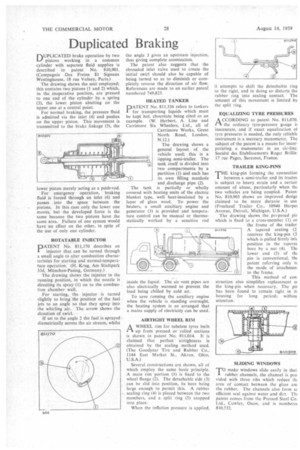Duplicated Braking
Page 78

If you've noticed an error in this article please click here to report it so we can fix it.
DUPLICATED brake operation by two pistons working in a common cylinder with separate fluid supplies is described in patent No. 810,901. (Compagnie Des Freins Et Signaux Westinghouse, 18 rue Volney, Paris.)
The drawing shows the unit employed; this contains two pistons (1 and 2) which, in the inoperative position, are pressed to one end of the cylinder by a spring (3), the lower piston abutting on the upper one at a central point.
For normal braking, the pressure fluid is admitted via the inlet (4) and pushes on the upper piston. This movement is transmitted to the brake linkage (5), the ower piston merely acting as a push-rod.
For emergency operation, braking fluid is forced through an inlet (6) and passes into the space between the pistons. In this case only the lower one moves, but the developed force is the same because the two pistons have the same area. Failure of one system would have no effect on the other, in spite of the use of only one cylinder.
ROTATABLE INJECTOR
DATENT No. 811,170 describes an
injector that can be turned through a small angle to alter combustion characteristics for starting and normal-temperature operation. (H. Krug, Am Stadtpark 33d, Miinchen-Pasing, Germany.) The drawing shows the injector in the running position, in which the nozzle is directing its spray (1) on to the combustion chamber wall.
For starting, the injector is turned slightly to bring the position of the fuel jets to an angle so that they spray into the whirling air. The arrow shows the direction of swirl. • If set to the angle 2 the fuel is sprayed diametrically across the air stream, whilst the angle 3 gives ark upstream injection, thus giving complete atomization.
The patent also suggests that the shrouded inlet valve used to create the initial swirl should also be capable of being turned so as to diminish or completely reverse the direction of air flow. References are made to an earlier paled numbered 749,825.
HEATED TANKER DATENT No. 811,336 refers to tankers for transporting liquids which must be kept hot, chocolate being cited as an example. (W. Herbert, A. Line and Carrimore Six Wheelers, Ltd., all of Carrimore Works, Great North Road, London, N.12.) The drawing shows a general layout of the vehicle used; this is a tipping semi-trailer. The tank itself is divided into two compartments by a partition (1) and each has its own filling manhole and ,discharge pipe (2).
The tank is partially or wholly covered with heating units of the electric blanket type, well heat-insulated by a layer of glass wool. To power the heaters, a small auxiliary engine and generator (3) is provided and temperature control can be manual or thermostatically worked by a sensitive rod inside the liquid. The air vent pipes are also electrically warmed to prevent the toad being chilled by cold air.
To save running the auxiliary engine when the vehicle is standing overnight, the heating system is so 'arranged that a mains supply of electricity can be used.
AIRTIGHT WHEEL RIM
AA WHEEL rim for tubeless tyres built up from pressed or rolled sections is shown in patent No. 811,014. It is claimed Ihat perfect airtightness is obtained by the sealing method used. (The Goodyear Tire and Rubber Co., 1144 East Market St., Akron, Ohio, U.S.A.)
Several constructions are shown, all of which employ the same basic principle. A main rim portion (1) is fixed to the wheel flange (2). The detachable side (3) can be slid into position, its bore being large enough to permit this. A rubber sealing ring (4) is placed between the two members, and a split ring (5) snapped into place.
When the inflation pressure is applied, it attempts to shift the detachable ring o the right, and in doing so distorts the rubber ring into sealing contact. The amount of this movement is limited by the split ring.
EQUALIZING TYRE PRESSURES
ACCORDING to patent No. 811,070, the ordinary tyre-pressure gauge is inaccurate, and if exact equalization of tyre pressures is needed, the only reliable instrument is a mercury manometer. The subject of the patent is a means for incor. porating a manometer in an air-line, Societe des Etablissements Roger Brillie 17 rue Pages, Suresnes, France.
TRAILER KING-PINS
THE king-pin forming the connectior between a semi-trailer and its tractot is subject to heavy strain and a certair amount of abuse, particularly when thr two vehicles are being coupled. Paten' No. 810,903 shows an improved desigr claimed to be more durable in use (Fruehauf Trailer Co., 10940 Harpei Avenue, Detroit, _Michigan, U.S.A.)
The drawing shows the prvposed pir which is fixed to a cross-member (1) or the frame of the trailer
811336 A tapered seating (2;
receives the king-pin (3 which is pulled firmly int( position in the taperec bore by a nut (4). Thc lower end (5) of th( pin is conventional, 'tlit patent referring only tr the mode of attachmen to the frame.
This method of con struction also simplifies replacement ck: the king-pin when necessary. The pit has been found to remain tight in it housing for long period; withou attention.
SLIDING WINDOWS
rmake windows slide easily in thei rubber channels, the channel is pro vided with three ribs which reduce th; area of contact between the glass an; the rubber. The channels also form as efficient seal against water and dirt. Thi patent comes from the Pressed Steel Co. Ltd., Cowley, Oxon, and is numberek 810,732.




















































































































